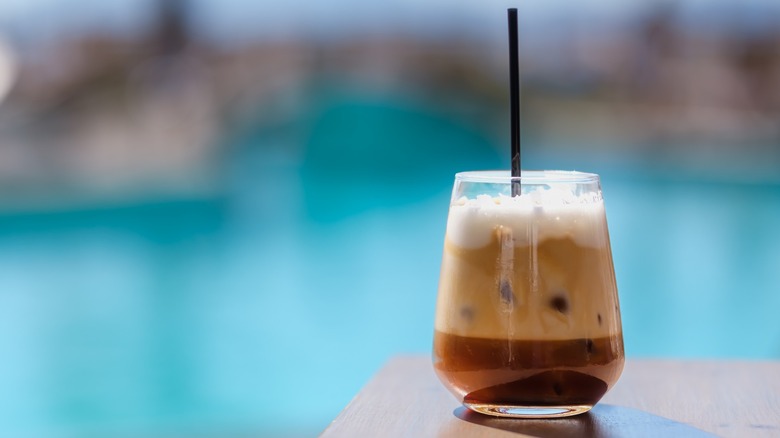Freddo Cappuccino Is The Iced, Greek Version Of The Coffee Drink
Despite being an import from the Ottoman Empire all the way back in the 15th to 16th century, coffee has nevertheless become an integral part of Greek culture today. As such, if you ever get the chance to visit the Mediterranean country, trying the traditional ellinikós kafés (Greek coffee) is a must. Among younger Greeks, the freddo cappuccino, a Greek twist on the Italian cappuccino, has gained immense popularity in recent years.
In the 1990s, the freddo cappuccino emerged as a close relative of the cafe frappé. However, it stood out from its cousin by using fresh espresso as the base for the drink instead of instant coffee. To make a freddo cappuccino, a barista will first combine two shots of bold espresso pressed from fresh Arabica beans, which are preferred in Greece, with a little ice in a drink mixer. For those who like their coffee sweeter, sugar is an optional ingredient. As its name "freddo" suggests (it means "cold" in Italian), the mixture is then poured over ice. Lastly, cold frothed milk foam (afrogala), is added to the top. And that's that: a freddo cappuccino.
The combination of its bold taste and coolness makes it the perfect pick-me-up for Greece's year-long warm and sunny climate. Though this is the version you'll find at most kafeterias, or Greek cafes, sometimes you can order a spin-off recipe: the freddo flat white. This version features cold, un-aerated milk as the base with a layer of aerated espresso on top. It's also served cold but merely chilled instead of over ice.
Is a freddo cappuccino the same as a freddo espresso?
While both the freddo cappuccino and the freddo espresso share the same basic build process, they are not quite identical twins. To make a freddo espresso, the barista also begins with a hot double shot of espresso in a drink mixer. However, instead of adding milk, they make a blended froth using only espresso, ice, and sugar. The result is an exceptionally bold and strong-tasting beverage that allows you to savor the full espresso flavor, without the softening influence of milk.
In a way, you could think of the freddo cappuccino as an upgraded version of the freddo espresso, as it is essentially the latter with the addition of cold milk foam. Nevertheless, the differences in texture and taste between these two drinks are significant enough that they are considered entirely distinct in Greece.
Speaking of enhancements, milk isn't the only ingredient you can introduce to a freddo espresso-based drink to enhance its flavor. Some enthusiasts have experimented with adding vanilla and even a touch of liquor to both of these beverages. It's said that this combination unlocks an entirely new dimension of flavor within the drinks. If you ever get the opportunity to try these out, whether at home or in a genuine Greek kafeteria, it's an idea definitely worth exploring!

